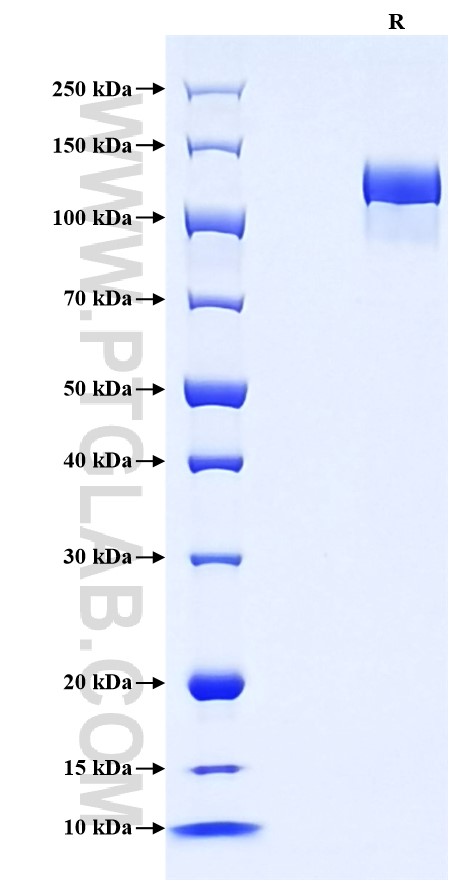Recombinant Mouse Tie-2/CD202b protein (rFc Tag)
种属
Mouse
纯度
>90 %, SDS-PAGE
标签
rFc Tag
生物活性
未测试
验证数据展示
产品信息
| 纯度 | >90 %, SDS-PAGE |
| 内毒素 | <0.1 EU/μg protein, LAL method |
| 生物活性 |
Not tested |
| 来源 | HEK293-derived Mouse Tie-2 protein Ala23-Lys744 (Accession# Q02858) with a rabbit IgG Fc tag at the C-terminus. |
| 基因ID | 21687 |
| 蛋白编号 | Q02858 |
| 预测分子量 | 106.9 kDa |
| SDS-PAGE | 120-140 kDa, reducing (R) conditions |
| 组分 | Lyophilized from 0.22 μm filtered solution in PBS, pH 7.4. Normally 5% trehalose and 5% mannitol are added as protectants before lyophilization. |
| 复溶 | Briefly centrifuge the tube before opening. Reconstitute at 0.1-0.5 mg/mL in sterile water. |
| 储存条件 |
It is recommended that the protein be aliquoted for optimal storage. Avoid repeated freeze-thaw cycles.
|
| 运输条件 | The product is shipped at ambient temperature. Upon receipt, store it immediately at the recommended temperature. |
背景信息
Tie-2, also known as CD202b or TEK, is a receptor tyrosine kinase (RTK) specifically expressed in endothelial cells. It plays a crucial role in angiogenesis, forming new blood vessels, and maintaining vascular stability. TIE-2 is a tyrosine kinase receptor expressed mainly by endothelial cells, cancer cells, and some immune cells like monocytes. Tie-2 is a member of the Tie receptor family, characterized by the presence of immunoglobulin and epidermal growth factor (EGF) homology domains. Tie-2 is selectively expressed in endothelial cells and gene deficiency of Tie-2 leads to embryonic lethality due to abnormal vascular development. Ang-1, which is secreted from perivascular cells, has been identified as the major ligand for Tie-2. Binding of Ang-1 to Tie-2 elicits different downstream signaling pathways mainly regulated by Akt, which induces pro-angiogenic responses including the promotion of endothelial cell migration, tube formation and survival.
参考文献:
1. Dumont DJ. et al. (1992) Oncogene. 7(8):1471-80. 2. Duran CL. et al. (2021) Cancers (Basel). 13(22):5730. 3. Sato TN. et al. (1995) Nature. 376(6535):70-4. 4. Isidori AM. et al. (2016) J Endocrinol Invest. 39(11):1235-1246. 5. Fukuhara S. et al. (2010) Histol Histopathol. 25(3):387-96.
